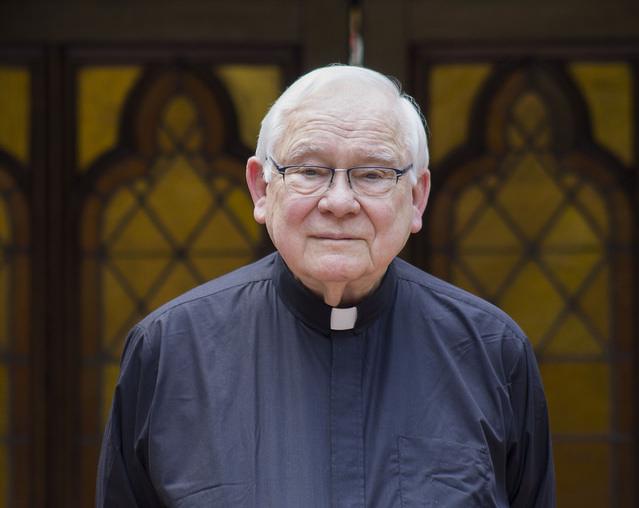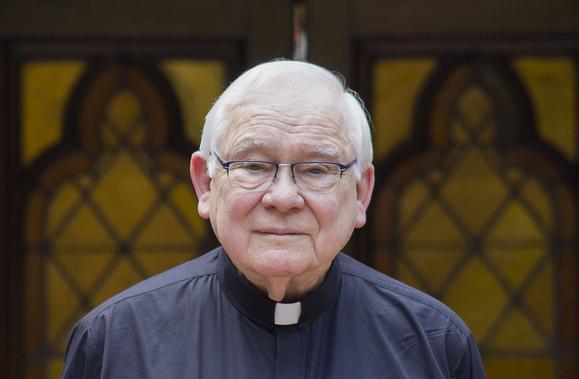Even at 87 years old, Fr. Howard Gray, S.J., commanded a presence at the pulpit. The pews were packed for his sacred lecture — a Jesuit tradition — in Dahlgren Chapel last month. It was his first public appearance at Georgetown University since he retired as head of the Office of Mission and Ministry last August.
Gray launched into his April 18 lecture with his characteristic combination of gentleness and gravitas, developed over seven decades of sermonizing. His opening words were not his own but rather from a poem by Mary Oliver. He had chosen them as a fitting introduction to the theme of his lecture: how to draw goodness out of others simply by being good.
“I know a man of such mildness and kindness it is trying to change my life. He does not preach, teach, but simply is,” Gray preached to the Wednesday evening crowd. “He is kind with the sort of kindness that shines out but is resolute, not fooled. He has eaten the dark hours and could also, I think, soldier for God, riding out under the storm clouds against the world’s pride and unkindness, with both unassailable sweetness and consoling word.”
This lecture would be Gray’s last public words at Georgetown. He died Monday, May 7, at St. Joseph Mercy Oakland hospital in Pontiac, Mich., from complications from a car accident four days earlier. He was buried at All Saints Cemetery in Northfield, Ohio, his hometown, on May 12.

Fr. Howard Gray, S.J., a former head of the Office of Mission and Ministry and member of Georgetown’s Jesuit community since 2007, died Monday because of complications from a car accident in Michigan.
For those who knew Gray, his final lecture continues to echo: He is remembered by his friends as a “spiritual giant” and a “quiet leader” who set a sterling example for others to follow.
“He will be dearly missed — as a steadfast friend, extraordinary scholar, and wise leader — to many of us here at Georgetown and others throughout the Society of Jesus and institutions of higher education across our country,” University President John J. DeGioia wrote in a campuswide email May 8.
At Georgetown, Gray was a spiritual adviser to DeGioia and other senior administrators, a champion of LGBTQ inclusion and an advocate of interreligious dialogue. He also earned an international reputation as a scholar and a “guru” in Ignatian spirituality, credited with reviving the core of the Jesuit tradition with a renewed focus on individual spiritual growth and inclusivity.
———
Before coming to Georgetown in 2007, Gray was a prominent leader in the Jesuit community for decades. Gray was born in Cleveland in 1930 and joined the Society of Jesus in 1948, thereafter serving in a range of positions at Jesuit institutions during his seven decades in the society, including at Boston College, Loyola University of New Orleans and the University of Detroit Mercy.
Gray first served Georgetown as a member of the university’s board of directors from 1997 to 2006. During his term, the board oversaw the construction of several new buildings, including the Southwest Quad dormitories and Wolfington Hall, the new Jesuit residence. In 2001, the board appointed DeGioia to the post of university president as the first non-Jesuit to take the helm of any U.S. Jesuit college or university.
Gray initially expressed preference for a Jesuit to fill the presidential post, but he became a “champion of the way that lay leadership can work in Jesuit institutions,” according to Fr. Matthew Carnes, S.J., a Georgetown Jesuit and government professor.
“He had a sense that lay people can be leaders, and then what the Jesuit role becomes is continuing to care for the spirit of the institution,” Carnes said.
He took on this supportive role in 2007, when he joined the university’s Jesuit community as special assistant to the president. For the next decade, Gray served as a spiritual adviser to DeGioia and other senior administrators, while overseeing a number of administrative tasks, including headhunting candidates for key positions in the Office of Mission and Ministry.
As a Jesuit leader on campus, Gray championed a vision of the Jesuit identity that embraced openness and inclusion. Gray was part of a generation of Jesuits that “rediscovered the spirituality of the Jesuits” as focusing on the individual and their relationship with God — a spiritual conviction that led him to embrace diversity in a way that some others in his church did not, according to Carnes.
“Just think of the different identities that you can cherish when you cherish the individual,” Carnes said. “And that was something he did so well, and everything flowed from that.”
In 2008, Gray stood up against conservative elements in the Catholic church as a strong advocate for the founding of an LGBTQ Resource Center at Georgetown, the first of its kind at a Jesuit university in the United States. Gray’s advocacy was “instrumental” in providing the center with the moral authority it needed to get off the ground, according to Shiva Subbaraman, the center’s director.
“He always pointed out that we had an obligation to have the Center ‘because’ we are Jesuit and Catholic, not ‘despite’,” Subbaraman wrote in an email to The Hoya. “Fr Howard Gray ‘saw’ LGBTQ people in all of our full range of humanity.”
In 2016, Gray accepted DeGioia’s call to lead the university’s large and complex Office of Mission and Ministry as interim vice president following the resignation of Fr. Kevin O’Brien, S.J., to become dean of the Jesuit School of Theology at Santa Clara University. It was a demanding role, particularly with Gray’s physical health declining at the age of 86. That fall, Gray faced health episodes stemming from a heart condition, always returning to work shortly thereafter. He fulfilled the role with “incredible energy and enthusiasm” the entire year, Carnes said.
Gray embraced and promoted religious diversity at Georgetown and was particularly fascinated by interreligious dialogue: Gray was beloved by many of the university’s chaplains, Catholic and non-Catholic, whom he would often engage in theological discussion, according to colleagues. While leading the Office of Mission and Ministry, Gray welcomed Georgetown’s first full-time director of Hindu life and the first Hindu priest to be a chaplain at any U.S. university, Brahmachari Vrajvihari Sharan.
After his yearlong term heading the Office of Mission and Ministry, Gray largely retired from public life and moved to a Jesuit retreat home in West Bloomfield, Mich.
Aside from his official responsibilities, over his decade on campus, Gray frequently played the role of spiritual guide to members of the administration, faculty, student body and Jesuit community. His first-floor office in Gervase Hall, the inconspicuous brick building adjoining Isaac Hawkins Hall near Dahlgren Quad, became a chapel in its own right for members of the community seeking wisdom or support.
Gray listened closely and asked pointed questions, according to Carnes. A lover of literature and the written word, he would often provide wisdom in the form of scripture verses, lines from old novels or anecdotes from his personal life.
“He was someone who could make time for you and sit down with you and talk about the big and the small things in your life, and give you his absolute, undivided attention,” Carnes said. “And by doing that, to call out the best in you and help you bring out and see the best in yourself.”
———
Impressive as Gray was as a leader, his friends will remember him even more for who he was as a friend. While Gray was a “spiritual giant,” Fr. Gregory Schenden, S.J., said, he was also “so fully human.”
Few people were closer to Gray than Fr. John O’Malley, S.J., 90, one of his best friends of seven decades and a Georgetown theology professor. At Georgetown, the two elder Jesuits were next-door neighbors in Wolfington Hall, with Schenden on Gray’s other side.
“They would knock on each other’s doors and bug each other sometimes,” Carnes said. “The two of them could be so much fun to see together, play off one another, encourage each other and laugh at one another and themselves.”
In a sermon at Gray’s funeral Saturday, O’Malley recalled how he and Gray “bantered and teased and feigned indignation at one another’s foibles.”
“You might gather some insight into the quality of our friendship if I tell you that sometimes with me he began a conversation by asking the endearing question, ‘Do you know what’s wrong with you?’” O’Malley said.
Gray had a playful sense of humor, as well as a taste for film that extended from foreign-language dramas to slapstick comedies, and he could enjoy a drink or two: Bourbon Manhattans were his favorite, according to Schenden.
Gray often stayed in touch with old friends by sending notes and cards, usually picked up from museums or from his travels — something with an artistic flourish, and always carefully chosen for the right person and moment, according to Carnes.
Gray and his sister, Marge, were particularly inseparable: He called her nearly every day and made trips to visit her most holidays. They often told stories about their mother and how much they had learned from her as kids about teaching love and virtue by example. This lesson would be the theme of Gray’s final lecture at Georgetown, and according to his friends, the hallmark of his legacy on campus.
While Gray was in town for his lecture last month, he made sure to keep a busy schedule of dinners and other occasions to share with old friends, including meeting his old next-door neighbor Schenden for a nightcap on the evening of April 18 after his lecture.
Schenden recalled telling him, “You know, How, I didn’t realize until these days you’ve been back how spoiled I was having you here in my life each and every day.”
Gray certainly felt likewise. In a 2013 viewpoint published in The Hoya, Gray reflected on how he had learned to see his friends as “gifts to be valued.”
“Throughout our ordinary days, we are surrounded by other women and men who are gifts,” Gray wrote. “If I look back over the years, I see all the people who’ve populated my history not as a cast of characters but as good folks who taught me how to understand life, how to support others, how to laugh through my tears and sorrows, how to extend myself in compassion and care and how to forgive and be forgiven.”





















